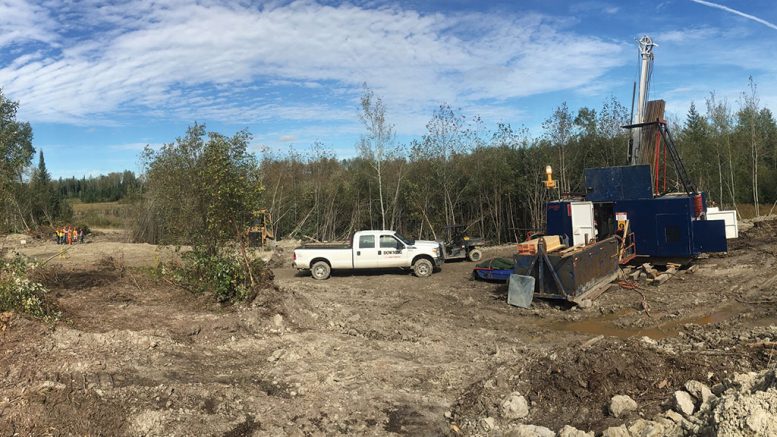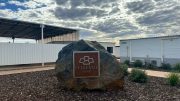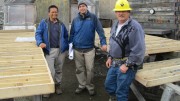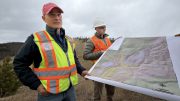DRYDEN, ONTARIO — A dirt road leads across a bushy plot of land to a small wooden building: Treasury Metals’ (TSX: TML) project office on its wholly owned Goliath gold property. Storage sheds sit further back, housing the core samples that analysts and investors will soon examine.
Goliath is one of Treasury’s three properties, but it is by far the most explored and developed, with power lines already set up. The company’s two other properties — Goldeye, located 227 km north of Red Lake in northwestern Ontario, and Lara, located 25 km west of Chemainus on Vancouver Island — have yet to receive preliminary economic assessments (PEAs).
According to a 2017 PEA at Goliath, Treasury could produce a total 9.8 million tonnes grading 3.81 grams gold per tonne. At a 2,500-tonne-per-day production rate, the company would produce 1,142,000 oz. gold over an anticipated 13-year mine life. Gold production would peak at 111,800 equivalent oz. gold per year in year six, but settle into an average 87,850 equivalent oz. gold per year. The PEA uses a US$1,225 per oz. gold price. The post-tax net present value is $306.1 million at a 5 % discount rate. The post-tax internal rate of return is 25% for a 4.1-year, post-tax payback.

Core samples at Treasury’s Goliath gold project. Photo by Richard Quarisa.
The proposed operation would feature an open-pit and underground mine. Based on over 140,000 metres of exploration drilling, the open-pit outline contains 18 million measured and indicated tonnes at 1.26 grams gold per tonne and the underground portion contains 2.4 million measured and indicated tonnes at 4.95 grams gold per tonne, for a total 20 million measured and indicated tonnes at 1.69 grams gold per tonne.
Goliath is in the Archean Superior geological province, north of the Wabigoon fault. It is mostly an amphibolite, metamorphic-grade, volcanogenic sedimentary complex topped by an upper layer of greenschist. The assemblage comprises quartz-porphyritic felsic to intermediate metavolcanic rocks. All the rocks have been subject to folding and moderate to intense shearing.

Treasury Metals’ CEO Chris Stewart. Credit: Treasury Metals.
Gold mineralization occurs within a 100- to 150-metre-wide central zone.
The 50 sq. km property is 15 km west of Dryden, a small city on Wabigoon Lake in the Kenora district. With a population of 7,750 people, it is the smallest city in Ontario. Stewart is confident, however, that attracting a workforce will not be an issue.
Dryden is perhaps best known in the region for its pulp and paper mill that opened in 1913. After changing ownership several times, it still clings to life.
In November 2008, Domtar (TSX: UFS; NYSE: UFS) stopped paper production at Dryden’s pulp-and-paper mill. The move put 190 of the mill’s 530 employees out of work. Then, in April 2009, Domtar suspended pulp operations for 10 weeks. The company said it could no longer operate at the same capacity due to a global decline in the demand for pulp. Several hundred workers were laid off. Although some returned to work, many did not.
“A lot of people do work outside of town because of the loss of jobs at the big pulp and paper mill,” Stewart says. “You’ve got people who are travelling to Red Lake, for example, and some guys go to the tar sands as well. I think there will be a few people that are there you can hire and some you can attract, and certainly an opportunity we see is with the local First Nations communities.”

Treasury’s project office on the Goliath gold site. Photo by Richard Quarisa.
First Nations members account for 16% of Dryden’s population. The Wabigoon Lake Ojibway Nation, 16 km southeast of the city, has a population of more than 500 people. While the two parties have yet to agree to a memorandum of understanding (MOU) or an impact and benefit agreement (IBA), Stewart is optimistic.
“I’d say certainly in the last year we’ve made some significant in-roads there at building relationships with the First Nations and the Metis,” he says. “So we’re in discussions with them right now around MOUs and IBAs, and all that kind of stuff.”
Stewart also points out that Dryden is in between Thunder Bay and Winnipeg, which are a three-hour drive either way along the Trans-Canada highway. He says this is not only another selling point for Dryden, but also a logistical bonus: getting construction materials into the area wouldn’t be hard.
So far, Treasury has spent more than $55 million on drilling. This is partly because it hasn’t had to spend much on infrastructure.
“When you look at a lot of the projects that are getting built out there,” Stewart says, “where they have the most problems and the overrun is on the civil surface stuff, with road construction, bridges, soils, getting power lines in, and having to cross creeks and rivers. We essentially don’t have any of those challenges because everything is there already.”
The Goliath property is a combination of two older properties owned by three companies: Teck Resources (TSX: TECK.B; NYSE: TECK) and Corona Gold’s Thunder Lake property, and the Laramide property, formerly owned by Laramide Resources (TSX: LAM). Teck formed a joint-venture partnership with Corona in 1996 and drilled until 1998. By 1999 the companies had outlined most of what is now considered the Goliath deposit.
That has freed up Treasury to focus on other aspects of the project. Right now, Stewart says Treasury is working on three things.
“Infill drilling, and then a bit of step-out drilling to the northeast on the exploration front, the permitting process and then the feasibility study. Those are the three big buckets that we’re focused on right now.”
Another 15,000 metres of drilling would convert inferred resources to indicated resources. Across the open-pit and underground mine, Treasury estimates 3.4 million total inferred resources at 2.96 grams gold per tonne. The second 15,000 metres of drilling would expand the underground zone and move out of the open pit to explore the northeast area.
Treasury needs funding to complete its 2017–2018 drill program and move beyond it. The company predicts an initial $133-million capital expense and a US$611-million all-in sustaining cost. The average yearly operating cash cost is set at $58 million.
Stewart says Treasury is looking for “a strategic partner to come in and take a position in the company.” He says the company would rather get a private placement than go back to the market.
“We’ve been working on that for the last couple of months, and we’re having some pretty good traction.”






Be the first to comment on "Sit visit: Treasury moves Goliath forward with updated PEA"